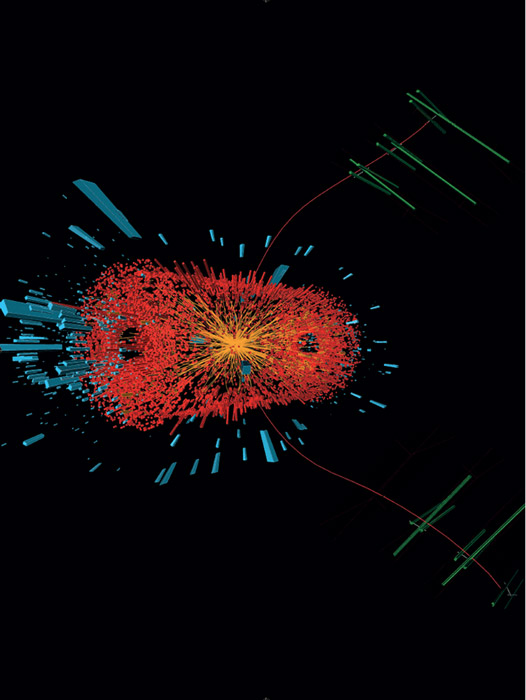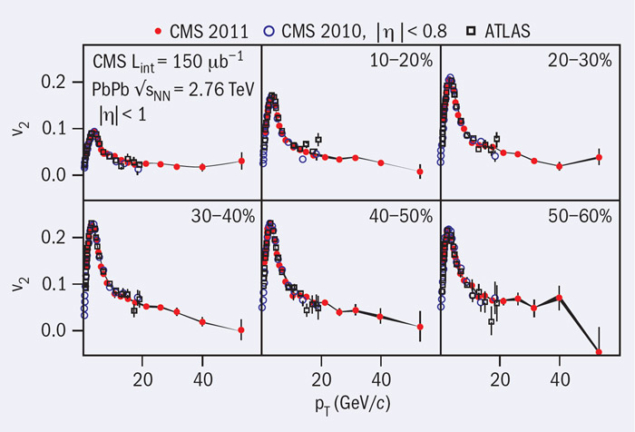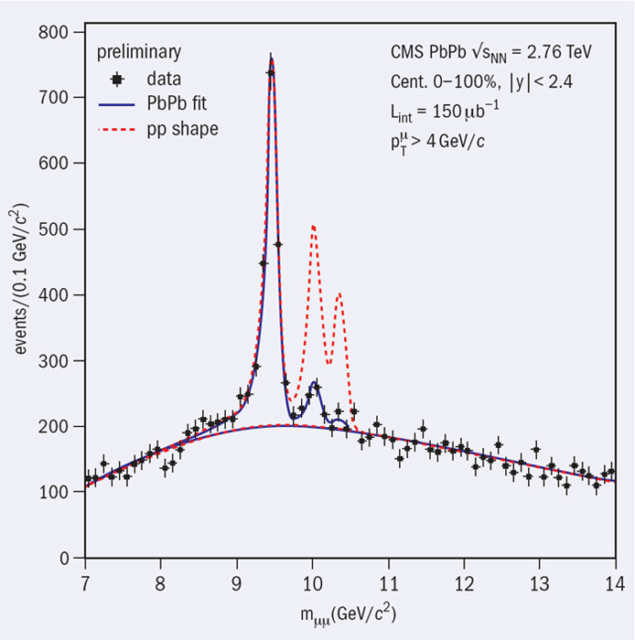Results from a multifaceted heavy-ion programme.

When atomic nuclei collide at high energies, they are expected to “melt” into a quark–gluon plasma (QGP) – a hot and dense medium made out of partons (quarks and gluons). At the LHC, many of the observed properties of the produced matter are consistent with this picture, similar to earlier findings by experiments at the Relativistic Heavy Ion Collider (RHIC) at Brookhaven National Laboratory and at CERN’s Super Proton Synchrotron. The quantitative characterization of this medium is still far from complete, but with more than an order of magnitude increase in the collision energy, the LHC is providing a tremendous opportunity to extend the studies. In particular, the higher energy collisions create much greater abundances of rare probes of the hot matter – such as jets (groups of high transverse-momentum (pT) particles emitted within a narrow cone), or bound states of heavy quark–antiquark pairs.
With its flawless performance in the heavy-ion run, the LHC exceeded the projected luminosity for lead–lead (PbPb) collisions in 2011, allowing the CMS experiment to record an integrated luminosity of 150 μb–1 at a nucleon–nucleon centre-of-mass energy of √sNN = 2.76 TeV, the luminosity being approximately 20 times more than in 2010. This new data set gives the CMS collaboration the opportunity to perform a detailed investigation of the medium using probes that are available for the first time in heavy-ion collisions, in a physics programme that partially overlaps but largely complements and extends the range of heavy-ion research conducted by the ALICE and ATLAS collaborations at the LHC. This article describes some of the heavy-ion results that CMS has obtained so far, with an emphasis on unique findings from the high-luminosity data.
The CMS heavy-ion programme is multifaceted, based on the diverse capabilities of the CMS detector and the broad interests and expertise of the members of the collaboration. The key to its success lies in the careful planning, support, expertise and hard work of the entire CMS collaboration. A well optimized triggering strategy with robust algorithms was in place for the 2011 run, allowing CMS to take maximum advantage of the delivered luminosity. A detailed inspection of each heavy-ion event was performed by the level-1 and high-level trigger systems, and the most interesting events containing rare signals were written to tape.
Properties of the bulk medium
Using the 2010 data, the LHC experiments were able to characterize the bulk properties of the partonic medium. The CMS collaboration performed detailed studies of soft-particle production by measuring the charged-particle multiplicity, transverse energy flow, azimuthal asymmetry in charged-particle and neutral-pion production, and two-particle correlations. The number of produced particles changes by orders of magnitude depending on whether the collision is “head-on” (central) or peripheral. The centrality of the PbPb collisions is characterized by the energy deposited in the forward calorimeters of the CMS detector, covering small polar angles with respect to the beamline (i.e. the pseudorapidity interval 3 < |η| < 5.2), with the most central collisions leaving the largest amount of energy in the detector. The events are then categorized based on this energy into percentile intervals of the total inelastic hadronic PbPb cross-section (the 0–20% centrality class meaning the 20% most central collisions, etc). Quantitatively, the centrality is usually characterized by the number of nucleons participating in the actual collision (i.e. those in the overlap zone of the two nuclei) denoted by Npart.

As experiments at RHIC had previously observed, the hot matter produced at the LHC exhibits strong collective-flow behaviour. In off-centre collisions the initial nuclear overlap zone is spatially asymmetrical with an approximately ellipsoidal shape. This asymmetry leads to instantaneous pressure gradients that are more effective in pushing particles out from the collision zone along the minor axis of the ellipse, rather than perpendicular to it. As a result, the matter produced in the collision undergoes anisotropic expansion, which is observed as a collective flow of particles with distinct azimuthal asymmetry. A Fourier analysis of the azimuthal angular distribution of the final-state particles reveals important aspects of the collision dynamics, and provides constraints to the equation of state and the viscosity (resistance to flow) of the medium.
For head-on PbPb collisions, CMS estimates the energy density per unit volume to be about 14 GeV/fm3 at a time of 1 fm/c after the collision, which is about 100 times larger than the density of normal nuclear matter and 2.6 times greater than obtained at the highest RHIC energy. A significant increase of the mean transverse energy per particle is similarly observed. Despite this increase, the trends in the collective flow and correlation measurements show relatively modest changes compared with RHIC, indicating that the general properties of the matter produced at the LHC, as observed through the study of soft particles, are consistent with a strongly interacting partonic medium.
Jet quenching
A key diagnostic tool that provides information about the density and composition of the medium produced in high-energy heavy-ion collisions comes from the measurements of high transverse-momentum jets. These “hard probes” result from relatively rare violent scatterings of the quarks and gluons that comprise the incoming nuclei. Since the production cross-sections of these energetic partons are calculable using the well established techniques of perturbative QCD, they have long been recognized as particularly useful “tomographic” probes of the hot medium.
The majority of the produced jets originate in the scattering of gluons or light quarks (up, down or strange), which are expected to lose energy while propagating through the medium. Less frequently the outgoing parton is a heavy charm or bottom quark that may also interact – although possibly less strongly – with the medium. Of particular interest are the events that produce hard-scattering probes that do not interact strongly, such as prompt photons or weak bosons, as they provide precise constraints on the energy of the recoiling parton and enable a controlled measurement of the parton energy loss in the medium. Multiple complementary measurements involving different probes can be performed using CMS, because of the detector’s high resolution, granularity, large acceptance, high-rate read-out capability and triggering.
The enormous energy loss of the partons propagating through the hot and dense medium became immediately apparent in the online event displays of the first PbPb collisions in the LHC, which revealed strikingly unbalanced dijet events and photon–jet events (figure 1). Subsequently, both ATLAS and CMS published detailed studies of the dijet transverse-momentum asymmetry. CMS expanded on this initial observation with a comprehensive set of measurements aiming not only to quantify the amount of lost energy, but also to answer the question: “Where does the lost energy go?”
The data from jet-track correlations indicate that the large energy lost by the partons is transferred to soft hadrons, which are scattered relatively far away in rapidity from the jet axis. To investigate the possible modifications of the jet structure, measurements of the jet shapes and fragmentation functions are also pursued. The high-luminosity data set collected in 2011 allows for further characterization of the dijet momentum-
imbalance, by studying jets up to unprecedented values of transverse momenta. CMS has recently published a paper on this dijet momentum-imbalance, which is found to persist in central collisions up to the highest values of leading-jet transverse momenta studied – even the most energetic jets do not escape the medium unaltered.

Further tests of the jet-quenching hypothesis use control measurements involving probes that do not interact strongly, such as photons, Z and W bosons. The transverse-momentum spectra of charged hadrons and isolated photons are compared with their equivalents in pp collisions. Figure 2 shows the suppression factor, RAA, of the production rates of high transverse-momentum particles, scaled to be unity if nuclear collisions are a simple superposition of pp collisions. As expected, a strong suppression is observed for charged particles (RAA < 1), but the yields of electroweak probes appear unaffected by the medium (RAA ≈ 1). The measurement of b-decays to J/Ψ particles shows clearly that b-quarks are also strongly suppressed.
Having seen that isolated photons do not suffer suppression in the medium, CMS took the study to the next level using the high-luminosity data from 2011. The first measurement of a photon–jet imbalance was performed by examining events containing an isolated photon (γ) with pT > 60 GeV/c and an associated jet with pT > 30 GeV/c. The transverse momenta of the jet and the photon are compared by forming the ratio xjγ = pT(jet)/pT(γ). Figure 3 shows the centrality dependence of the average momentum imbalance, as well as the fraction of isolated photons with an associated jet partner Rjγ. The measurements in PbPb collisions are compared with those in pp collisions at the same energy and simulations that do not include the jet-quenching effect. A significant decrease in <xjγ> and Rjγ compared with the simulation is observed for more central PbPb collisions, indicating a larger parton energy loss in the collisions where the volume of the medium is larger.

While the jet-quenching phenomenon is undoubtedly established from the data, a complete theoretical understanding of the underlying parton energy-loss mechanism is still lacking. The data sample with 150 μb–1 integrated PbPb luminosity allows the study of the azimuthal anisotropy of charged-particle production up to high pT, providing additional information on the path-length dependence of the in-medium parton energy loss. Since the initial nuclear overlap zone for off-centre collisions is azimuthally asymmetrical with approximately ellipsoidal shape, partons propagating in the direction of the minor axis of the ellipse are expected to lose less energy than those propagating along the major axis. This leads to a final particle distribution (at any given transverse momentum) that is not cylindrically symmetrical, but has a cosine-shaped modulation as a function of azimuthal angle (that is, the rotation around the beamline). Figure 4 shows the half-amplitude of this cosine modulation, at different transverse-momenta and collision centralities. Nonzero elliptic anisotropy is observed even at high pT (up to pT ≈ 40 GeV/c) where most charged particles originate from the fragmentation of jets. These measurements are thus indirectly related to the amount of energy loss (and its dependence on the path length) of energetic partons inside the hot QCD medium.
Quarkonium suppression
The ultimate proof for the formation of QGP in heavy-ion collisions would be a measurement that demonstrates the presence of deconfined quarks and gluons. In the plasma state, the quark and gluon colour charges would be neutralized (or screened), similarly to the Debye screening of the electric charges of electrons and ions in an electromagnetic plasma. The colour-charge screening can be studied experimentally through the measurement of quarkonia, which consist of bound heavy quark–antiquark pairs (charm or beauty). In the QGP, the attractive force binding the pair together would be reduced, hindering the formation of the quarkonium states. Thus, observation of suppression in the production rate of these particles in comparison with the production rate in pp collisions is a signature of deconfinement, although other processes may obscure the effect.

CMS has excellent capabilities for muon detection and has measured the production rates of several particles (J/ψ, ψ(2S), ϒ(1S,2S,3S)) that have different radii and probe colour screening at different distance scales. The various quarkonium states are expected to “melt” in the QGP at different temperatures, corresponding to their respective binding energies. The measurement of the suppression pattern of several of these particles is thus needed to constrain the initial temperature in the collision and to demonstrate deconfinement.
The suppression of the excited states of the ϒ family was already seen in the 2010 data, albeit with limited statistical precision. With the high-luminosity data from 2011 the effect has been confirmed and studied in much more detail. Figure 5 shows the dimuon invariant-mass distribution obtained in PbPb collisions compared with the distribution measured in pp collisions, and clearly reveals the strong suppression of the excited ϒ states. To quantify the effect, the yields of the ϒ(2S) or ϒ(3S) states are compared with the yield of the ϒ(1S) state in PbPb and pp collisions by forming a double ratio: [ϒ(nS)/ϒ(1S)]PbPb/[ϒ(nS)/ϒ(1S)]pp. The values of these double ratios are determined to be 0.21 ± 0.07 (stat.) ± 0.02 (syst.) for n = 2 and less than 0.17 at 95% confidence level for n = 3. The individual ϒ(1S) and ϒ(2S) states are suppressed, compared with pp collisions, by factors of about 2 and 10, respectively. CMS thus finds the expected melting pattern, with the suppression being ordered according to the binding energy of the respective quarkonium states. The ψ(2S) state at high pT also falls into this picture, although a hint of an intriguing opposite trend was recently observed at low pT, but with limited statistical significance. More data are needed to confirm this observation, in particular a larger pp reference data set at the matching energy of 2.76 TeV.

By July 2012, the CMS heavy-ion programme had produced 16 papers submitted to refereed journals, of which 11 have already been published. More analyses are under way, and the collaboration is also preparing for the upcoming proton–lead collisions in the LHC, which will serve as a reference for normal nuclear effects. Such a control measurement, together with short, high-luminosity pp runs at 2.76 TeV and 5 TeV (to match the proton–lead collision energy) requested by CMS will complete the first round of pioneering investigations into the extremes of strongly interacting matter. With these data, the first steps of a journey back to the state of the universe just a few microseconds after the Big Bang are being taken at the LHC, and the CMS experiment is one of the “time-machines” making this exciting journey possible.








